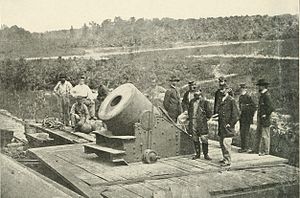
Back حصار بطرسبرغ Arabic Battaglia di Petersburg Corsican Belejringen af Petersburg Danish Belagerung von Petersburg German Campaña de Petersburg Spanish Petersburgin piiritys Finnish Siège de Petersburg French Assedio di Petersburg Italian リッチモンド・ピータースバーグ方面作戦 Japanese Richmond-Petersburgveldtocht Dutch
| Siege of Petersburg | |||||||
|---|---|---|---|---|---|---|---|
| Part of the American Civil War | |||||||
 The "Dictator" siege mortar at Petersburg. In the foreground, the figure on the right is Brig. Gen. Henry J. Hunt, chief of artillery of the Army of the Potomac. | |||||||
| |||||||
| Belligerents | |||||||
|
|
| ||||||
| Commanders and leaders | |||||||
|
|
| ||||||
| Units involved | |||||||
|
|
| ||||||
| Strength | |||||||
| 125,000 | 60,000[1] (estimate) | ||||||
| Casualties and losses | |||||||
| 42,000[2] (estimate) |
28,000[2] (estimate) 25,000 desertions[3] | ||||||
Location within Virginia | |||||||
The Richmond–Petersburg campaign was a series of battles around Petersburg, Virginia, fought from June 9, 1864, to March 25, 1865,[4] during the American Civil War. Although it is more popularly known as the siege of Petersburg, it was not a classic military siege, in which a city is encircled with fortifications blocking all routes of ingress and egress, nor was it strictly limited to actions against Petersburg. The campaign consisted of nine months of trench warfare in which Union forces commanded by Lt. Gen. Ulysses S. Grant assaulted Petersburg unsuccessfully and then constructed trench lines that eventually extended over 30 miles (48 km) from the eastern outskirts of Richmond, Virginia, to around the eastern and southern outskirts of Petersburg. Petersburg was crucial to the supply of Confederate Gen. Robert E. Lee's army and the Confederate capital of Richmond. Numerous raids were conducted and battles fought in attempts to cut off the Richmond and Petersburg Railroad. Many of these battles caused the lengthening of the trench lines.
Lee finally gave in to the pressure and abandoned both cities in April 1865, leading to his retreat and surrender at Appomattox Court House. The siege of Petersburg foreshadowed the trench warfare that would be seen fifty years later in World War I, earning it a prominent position in military history. It also featured the war's largest concentration of African-American troops, who suffered heavy casualties at such engagements as the Battle of the Crater and Chaffin's Farm.
- ^ William Marvel, Lee's Last Retreat: The Flight to Appomattox, Chapel Hill: The University of North Carolina Press, 2002, p. 208.
- ^ a b Chris Calkins. "Petersburg". Civil War Trust. Archived from the original on July 11, 2013. Retrieved September 27, 2013.
- ^ Earl Hess, In the Trenches at Petersburg: Field Fortifications and Confederate Defeat, Chapel Hill: The University of North Carolina Press, 2009, p. 280.
- ^ "Civil War Battle Summaries by Campaign". American Battlefield Protection Program. National Park Service. Archived from the original on November 11, 2017. Retrieved December 12, 2016.
© MMXXIII Rich X Search. We shall prevail. All rights reserved. Rich X Search
